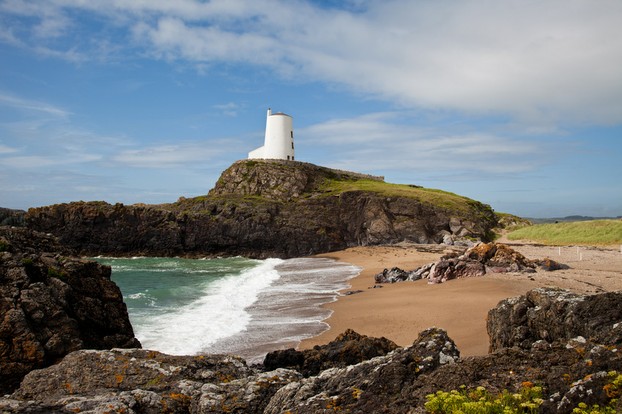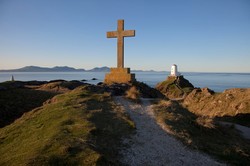Visitors to Anglesey seem to love it, and it is a popular place to live. The approach is by one of two bridges across the Menai Straits. These are a narrow geological fissure flooded by the sea, through which fast flowing currents surge, and these are especially strong in the narrowest part between the two bridges, far too strong for swimming. At the north eastern end of the straits the surge loses energy as its waters meet up with the Irish Sea, and they drop their sediment on the wide Lafan Sands, where there is a thriving mussel farm. In the Straits there are two small islets, where there are houses. These flood occasionally at high tide, and used to be a tourist attraction in Victorian times.
Strangely, the name Anglesey is misleading, as some think it connects the island with the Angles, the English. It doesn't and the strongly Welsh population would not be pleased with the mis-identification. The name derives from the Celtic tribe who once lived there, the Deceangli. This was a Latinization of a local pronunciation which may have been something like dchangli, but we cannot be certain. We do know that Latin transformed words that it absorbed. The suffix sey is a Norse word denoting an island. Many coastal names in the British Isles have a Norse derivation.
Before the Romans the Druids made it their sacred isle, and, as they were fierce opponents of the Roman conquest of southern Britain, the Romans decided to destroy them once and for all. Suetonius Paulinus, who seems to have been a brutal thug, brought the ninth legion to the island, where after a ferocious struggle they overcame the Druids and destroyed their sacred groves. However, while Druidry was seriously damaged in Britain it carried on in Ireland and Scotland and as Jo Harrington's articles claim it enjoyed a rebirth for a while in North Wales after the Romans left. Suetonius was called from his massacres on Anglesey by the revolt of Queen Boudicca, which he put down with his usual severity.
After the massacres Anglesey served as the grain growing area for the Roman legions, in an economy that eventually became overdependent on the military, a condition that ruined Celtic Britain when the legions were withdrawn and contributed to the chaos that brought the Anglo-Saxons.
In the nineteenth century there was a major development, the discovery of vast resources of copper, which made a great mining industry at Parys mountain and the resulting vast quarry. The small port of Amlwch developed to service the copper mining industry, and it still operates, even now the mine has closed, though as a tourist site.
It is now famed for Anglesey sea salt, distilled from the pure waters that surge past the isle.This salt is a favourite of many people who enjoy high quality cooking and with gourmet chefs.










 Women of the Gospelson 10/11/2025
Women of the Gospelson 10/11/2025
 Religious Gardenson 08/25/2025
Religious Gardenson 08/25/2025
 Doctor of the Church: John Henry Newmanon 08/03/2025
Doctor of the Church: John Henry Newmanon 08/03/2025
 Restoring the Palm Houseon 07/16/2025
Restoring the Palm Houseon 07/16/2025



Comments
Mona was sacred, but Holy Island was the Holy of Holies.
The first sentence in your introduction considers that "Anglesey is in fact two islands: Mona, the larger of the two, and Holy Island, once sacred to Druids, an island off an island."
Why was Mona not deemed sacred as well?
Mainly it is used by people who are foraging on their own land, as UK law forbids you to dig up a plant by its roots except on your own land or with landowner's permission.
The fourth paragraph to your second subheading, Newborough, considers silverweed as a starchy-rooted source for carbohydrates.
Is silverweed used nowadays culinarily, cultivationally or medicinally?
I am delighted that you liked the article. I am going to be visiting the island a few times in the coming months as our daughter on Anglesey is presenting us with a grandchild in November.
I'm Manx by heritage (live in America), but went to Wales, but only on the Mainland. Enjoyed reading this article!
As a child my family often visited North Wales in summer. I loved it there and still do.
Anglesey is a lovely island, beautiful villages, lighthouses, bays by the edge of the sea, old pubs.
Ty for posting this great article.
It is not for nothing that the first settlers called parts of the US east coast New England, and we can extend the comparison to Wales.
What a beautiful place! It reminds me of photos I've seen of the east coast in the U.S. I've never visited that part of the country, but maybe someday......
How nice! It's always lovely to be thought of by someone who is writing a positive piece!